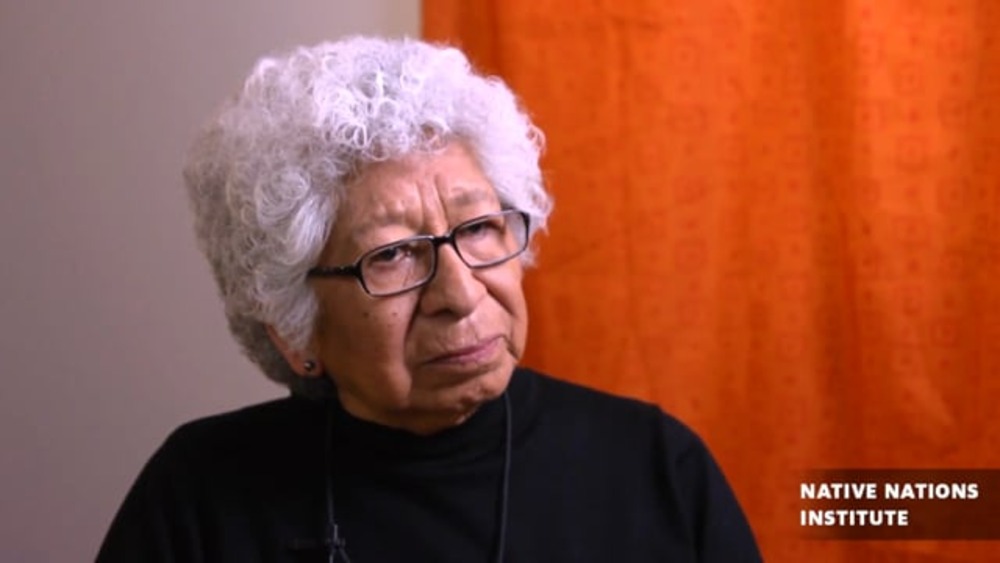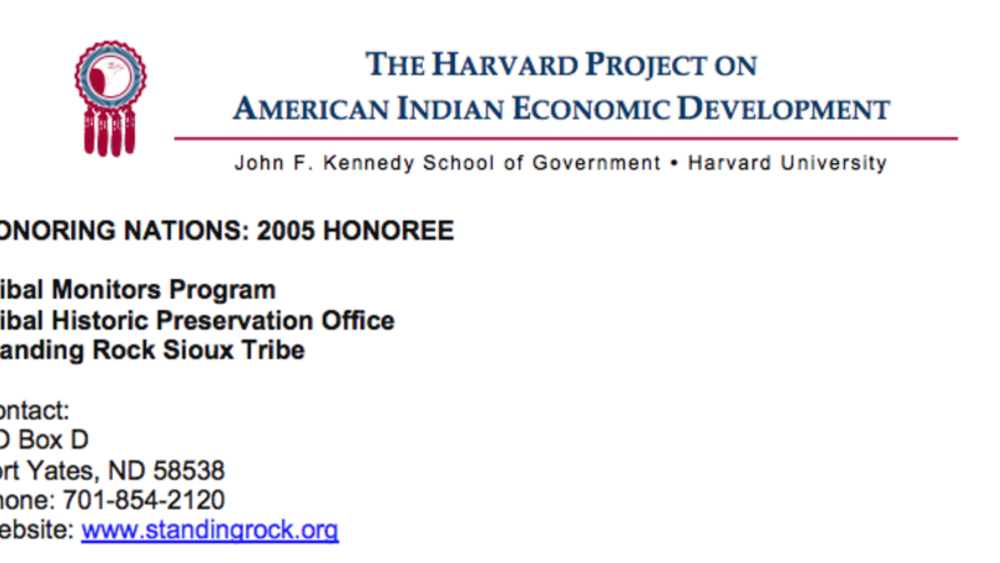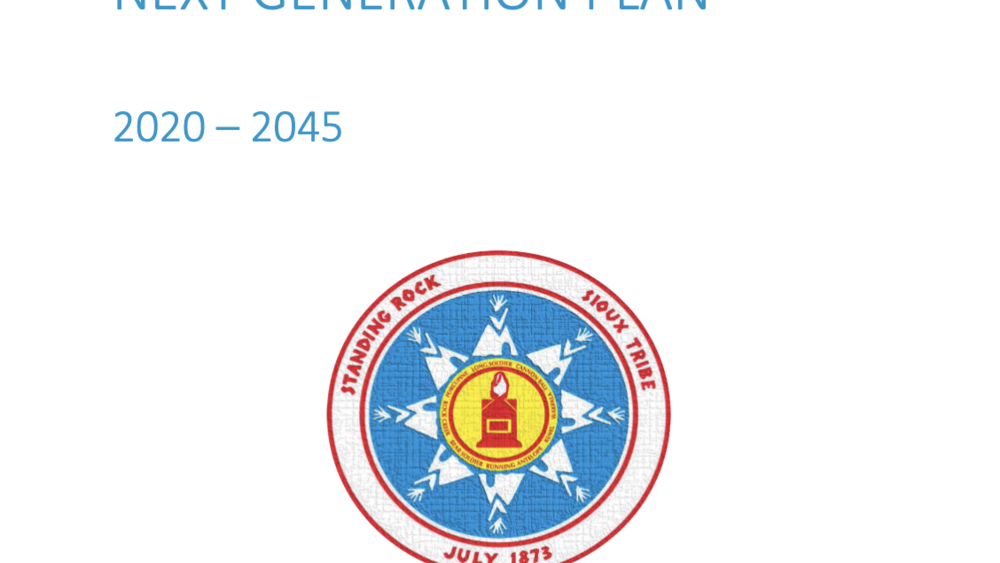Tim Mentz and Loretta Stone of the Standing Rock Sioux Tribal Monitors Program present an overview of the program's work to the Honoring Nations Board of Governors in conjunction with the 2005 Honoring Nations Awards.
Additional Information
Mentz, Tim and Loretta Stone. "Standing Rock Sioux Tribal Monitors Program." Honoring Nations Awards event. Harvard Project on American Indian Economic Development, John F. Kennedy School of Government, Harvard University. Tulsa, Oklahoma. November 1, 2005. Presentation.
Transcript
Loretta Stone:
"In the year 2000, the Tribal Monitors Program was instituted and partially funded through a programmatic agreement with the Army Corps of Engineers. The Tribal Monitors cover 2.3 million acres of land within the Standing Rock Reservation, which includes land covering two states, North and South Dakota. The sites we protect, survey and document are varied. Sites included are archaeological, which are burial, spiritual, sacred, village and massacre sites; historic, which would include Pre Pick-Sloan Dam; and paleontology, which includes at least 11 dinosaur sites all within Hell Creek Formation. Of these 11 sites, Tribal Monitors have discovered four. We have 66 documented village sites and the oldest one on Standing Rock is known as Potts. This village is estimated to be between 11,000 and 14,000 years old. Because of the site's documents age and it is along the river, it is a vulnerable site. This site is layered upon previous villages spanning thousands of years so this draws serious looters. Most of our villages run along the bank of the Missouri River. Ensuring that these sites are protected and treated with respect consumes a lot of our time but there are also numerous sites within the interior of Standing Rock that require our attention as well. The elders that we rely on have shared knowledge and purpose regarding effigies and inlaid sites. Their construction was and is the foundation of our spirituality. The determination of our spiritual leaders has withstood hundreds of years of weather, cattle, looting and neglect. Our spiritual people made sure that they had left visual reminders of our obligations to ourselves as well as our people. The elders within our communities have helped the Tribal Monitors understand the history and the stories associated with each of these sites. With regards to documented effigies, we have three turtles, one salamander and five snakes. The 400 documented inlaid sites consist of constellations, ring sites, rattles, medicine wheels and sundials to name a few. All of these particular sites held powerful spiritual reminders for all that utilized them. They serve as markers of where we are spiritually and where we need to be. They are presently being cared for by family and tribal members, just as they had been for hundreds of years. They are fed and prayed with perpetuating the cycle of spirituality. The Tribal Monitors have documented 10 individual massacre sites. These sites don't contain one or two burials but hundreds. These sites are particularly vulnerable because of the documented notoriety. Documented massacres within Standing Rock include but are not limited to the Crow, Arikara and Sioux Bands. We as Tribal Monitors keep a close eye on these sites because they are river sites with easy accessibility. We have 40 documented burial sites and the largest is Rocky Ridge. This site contains over 1,000 burials spanning over two miles of interconnecting hilltops. Rocky Ridge is both powerful and spiritual and a constant reminder of why we as Tribal Monitors do what we do. Rocky Ridge has had minimal site damage either by cattle or looting and it is the most well preserved site on Standing Rock. Rocky Ridge defines what we do because of the magnitude of the site. Within Rocky Ridge there are burials, sundials, crescent moons representing fasting sites, there is a stone alignment encompassing a hilltop; although it is now partially intact, it remains a powerful symbol of determination. Four of the five snake effigies are found on Rocky Ridge. The snakes encompass the base of two hills and are facing each other. The snakes represent the animal nations. Rocky Ridge contains a wealth of history and spiritual information. All of our dinosaurs are located within Hell Creek Formation. Because of the isolation and the distance of these sites, it can take a day to go out and check and monitor them. Because of the badland type terrain, it is usually impossible to go out and check with a vehicle. It's more feasible to use ATV. Of the 2.3 million acres, less than two percent has been surveyed, so in regards to inventory we have taken and documented 1,155 sites."
Tim Mentz:
"The Tribal Monitors Program continues to be a growing tribal regulatory function for the Standing Rock Sioux Tribe. Other tribes with a certified Tribal Historic Preservation Office are using their cultural knowledge to assist in the betterment of stewardship of their lands and sites and preserving and managing cultural and spiritual areas similar to how our ancestors once did. In our cultural resource code, the Tribal Monitors are the legal conduit representing the Tribal Historic Preservation Officer with federal agencies on federal undertakings. Within the Great Plains, the consistency of applying common law by these tribes with regulatory authority on these areas and the continued use of the natural laws of our grandmother by tribes have made federal agencies recognize the expertise of a tribal monitoring program and staff. Today, monitoring of significant cultural and spiritual areas is the only defense against looting and destruction of our cultural sites. With the identification of these sites, monitoring is the only practical way to manage these vulnerable areas. The tribal monitoring impact involving sacred and burial sites have been so great that the national policy has recently changed to adjust for more tribal involvement in management of areas significant to its people. We take pride in the fact that our program has shaped the way federal agencies are changing their management responsibilities with these areas. Because of this, we are sharing our procedural process with the other six tribes along the Missouri River to start a monitoring program this year. The regulatory authority and the jurisdiction of this office promotes good stewardship of ancient sites and allows for planned economic development in a structured process. The monitors locate and document areas significant to our tribes. Allowing our people to use spiritual areas long since standing idle has revitalized our youth and people to visit these areas. Numerous spiritual rides have taken our youth to visit these sites and to learn and understand how our ancestors once used these sites. Our spiritual riders are now making the annual Chief's Ride to include these particular areas that are very significant to our tribe. Tribes are taking control of lands within the reservations as old societies once did. These areas where our ancestors are buried and where they had their vision quests were protected by our warrior societies and were an important reason why the Indian wars occurred in the 1860s within the Great Plains and in other areas. Results of these violent wars against western expansion led to the treaty process for most tribes and the loss of using our spiritual areas' ancestral lands. With the Tribal Monitors Program expanding the responsibilities, the program has developed a plan and will create a stewardship program to put the elders, the youth, the spiritual practitioners back into the sacred areas of our reservation. [Lakota language]. 'One heart, one mind, one people.' That's our mission statement for our tribe and our office. [Lakota language]."
JoAnn Chase:
"Thank you so much. I have a great appreciation for the program. Certainly it has personal resonance for me as well as a member of the Mandan, Arikara, Hidatsa Nation. I have a two-part question for you. The first part of the question has to do with what I think has been a really impressive building of relationships with a number of different entities including but not limited to some of those very federal entities and agencies which in large part have created some of the problems that you are addressing, the Army Corps of Engineers, the Bureau of Indian Affairs, the U.S. Forest Service and so on. I wonder if you might speak just a little bit more to how...what measures you have taken and what measures you will continue to take to really ensure the promotion and protection of and continuation of tribal sovereignty and of self determination, particularly with respect to building relationships with those agencies. That's the first part of the question. The second part of my question has to do with sustainability of the program, and I'm really pleased and honored to see your tribal chairman here, which I think is an important statement of support for the extraordinary work that you're doing. But I also know that sustaining this kind of work can be very challenging and that in large part you depend on a number of volunteers. And I'm wondering also if you would please just talk a little bit more about how...what challenges you might see and how if you...how you may address those challenges in sustainability and if in fact there are plans underway to increase even the tribal support for the program that's in place now."
Tim Mentz:
"Thank you for that question. It's one that's very rooted real deep into Indian Country. First of all, we're dealing with the common law system or the federal legislation and those enactments of laws that created if you will a shroud of uncertainty related to how a federal process or a legislative process could enhance or at least identify and address those types of areas that are most particularly sensitive to the tribes, and that's the spiritual aspect or the natural law system with that aspect of a site given within these areas. Historically, we've looked back at how we have managed to progress all the way up to 1978, where the American Indian Religious Freedom Act had shaped a different understanding from a federal perspective, particularly with federal agencies. Since that time, from 1978 until today, we still continue to struggle to educate the federal system and the federal process, particularly when they start asking questions like, 'Would you be able to give us more information? Would you give us and allow us to hear what your understanding and knowledge is in relation to this site that we're looking at?' And usually we have to separate the archaeological context of that question versus the natural law system or the system that we grew up with. Obviously we have people at our home reservations that have a different knowledge that's not paper-based or what we call a degree. So we have to separate those and have to educate the process in itself. The hurdles that we have taken, from 1978 until today, has led us to understand that we cannot quantify our spirituality. We can't quantify these certain areas that we say that are very significant to us. So it's been a long road in relation to all the federal agencies, particularly the federal land-managing agencies that can very well say that, 'You do not have a piece of paper to go along with what you're saying in relation to this site.' But we say from the other side that, 'Grandmother has taken us this far.' We understand the natural laws that come along with it bridging the culture and the language to these sites is what we promote. That does not mean that the federal process has a space for that, but now with an enactment of the NAGPRA, the Native American Grave Protection Repatriation Act, and the '92 amendments to the National Historic Preservation Act has allowed us to progress to the point now where tribes are dealing with the federal agencies and we're stepping back also and looking at our people and saying, 'You know, how far do we go? How much knowledge, the sacred knowledge as we call it, do we divulge? Where's the fine line at? What can we document and what can't we document?' So those parts of that process has been included to get into what we call the consultation process of the federal system. The second part to your question is we have a number of elders, particularly our spiritual people that are now, we are setting them down and we're saying, 'Forgive us for asking these questions, but now the federal system has forced us to take a step forward and to address certain things that most generally we never talk about in public.' We don't divulge these types of sacred knowledge in public, but the question gets back to what I reiterated earlier, where's the fine line? So now we have our spiritual people actually stepping forward now and saying, 'Yes, maybe we're at the point now where we do have to document some of this knowledge that we have in order to protect these areas.' Until we can achieve that and that understanding from that perspective, it's growing now to the point that we want to have our children coming along with that process, with that discussion and now they're taking a step forward now with these youth rides, putting the horse back into these areas, putting that horse with the responsibility that leads with the horse and putting them back on the horse and getting back to the understanding of our warrior societies protected and fought these and they protected it very jealously, these types of areas. But now we're to the point, now it's the power of the pen and now bringing our spiritual people and our youth and elders together and now they're taking the point now where it's okay now to sit down and talk openly on our reservations now and talk about these things. So now we're pooling a lot of volunteers, particularly our elders that are stepping forward and saying, 'Yes, let's sit down and talk about these things,' and now creating a huge following that now is borne not only on leadership but the spiritual aspect."
David Gipp:
"One other question that I had. With what you're doing with the Tribal Monitors Program at Standing Rock, what other...how does this serve as a model for other tribes and I guess is there an effort, growing effort relative to other communities that you've had contact with on this kind of an effort?"
Tim Mentz:
"Yes, it has. Originally when we started talking about the 92 amendments we pushed for those types of procedures knowing that a procedural process has to be defined by tribes. Hence, we took those steps to know in the '92 amendments that it's okay to identify these people within the tribal structure to take steps similar to the National Historic Preservation Act that identifies Tribal Historic Preservation Officers that have [been] willing and have included in taking steps to do these types of areas and basically sit down with our people and say, 'Where are we going with this issue in relation to our cultural knowledge and our culture?' Hence that has broadened since the '92 amendments to include now that every reservation, particularly reservations, have a certain knowledge, a certain expertise and now we're bridging those gaps together and to form these types of collations and we're moving on a coalition right now in the Great Plains to gather all our cultural people and our cultural knowledge and now we have now affected and enhanced the process by bringing federal agencies and working collaboratively to educate them first off, but secondly to make them understand that we do have the expertise out there. Hence, programs are growing through the federal process, through the federal agencies that are recognizing our importance to the process, our cultural knowledge to the process, but more importantly the sustainability, that part of her question was, 'How do we sustain this process?' It's through our youth. We've got to put our youth back on the land. We have to put them back to the sites. We've got to let them take...walk off that black snake they call the pavement and they've got to walk over the hill. Hence, all these creations of these new programs that are happening on the reservations is a component that's going to not only enhance and enrich the process, but it's going to help us live on and bring those types of peoples together before that cultural knowledge is lost. Before our elders take it to the grave, we want to recapture it."



